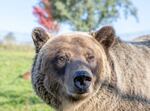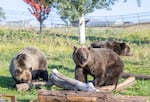
A grizzly bear at Washington State University's Bear Research Center in Pullman, Washington. The captive population of bears is helping scientists learn about insulin resistance in hibernation and how that compares to insulin resistance in diabetic people.
Robert Hubner/Washington State University
The behavior of grizzlies and other species of bears is tightly entwined with changes in the seasons. In the winter, bears enter their dens and hunker down to hibernate for months at a time. During this time, they go months without eating or drinking, living off the fat reserves they accumulated during the summer and fall when they gorged on salmon, berries and other food.
“During this period, they can even put on up to about nine pounds per day, in some cases,” said Blair Perry, a post-doctoral researcher in the School of Biological Sciences at the Washington State University in Pullman.
But it’s the unique adaptation and the biological changes it triggers within bears during hibernation that most intrigues Perry.
To cope with the rigors of fasting for months on end, bears develop resistance to insulin, a hormone critical to regulating levels of blood sugar in bears and humans.
“When blood sugar level increases, insulin also increases, essentially telling cells there’s plenty of sugar here, take it in, use it for energy,” Perry said.
“Insulin resistance is a condition where those cells no longer respond to insulin.”
Insulin resistance can be an early indicator for the development of type 2 diabetes, a chronic disease that can damage the kidneys and other vital organs if left untreated.
But bears, unlike people, do not develop diabetes. The seasonal insulin resistance they experience during the winter actually ramps up their ability to burn fat.
Perry and his team have discovered eight proteins in grizzlies that are critical to regulating insulin levels. They act like a switch, essentially telling cells to turn off their sensitivity to insulin when they hibernate and to turn back on in the spring when they emerge from their dens hungry for food and opportunities to mate.
The breakthrough for this discovery came from 11 captive grizzlies housed on the WSU campus that are playing a unique role in helping scientists learn more about bear behaviors and the genetic mechanisms underlying those behaviors. And by learning more about bears, scientists may also be able to learn more about biological processes shared with humans.

The Washington State University Bear Research Center in Pullman, Washington, has a population of captive grizzly bears that are helping scientists learn about insulin resistance in hibernating bears and how that compares to insulin resistance in diabetic people.
Robert Hubner/Washington State University / Robert Hubner
The grizzlies at the Washington State University Bear Research Center came from Yellowstone National Park and other wilderness areas where they grew too comfortable to the presence of humans and were given “a second chance,” according to Perry. They are now cared for and monitored year-round by a team of veterinary staff, scientists and students.
“So through training and reinforcement with food, we’ve trained these bears to be able to interact in safe ways with researchers … They can present a paw through an opening in the fence so that we can take a blood sample or give them exams,” Perry said.
Perry and his team took blood samples and cell cultures from the grizzlies at the research center during the summer when the bears were active and during the winter when they hibernated. They also took samples from bears who were coaxed out of hibernation for a period of two weeks using honey water, a favorite treat of theirs.
When the researchers exposed the cell cultures taken during hibernation with blood taken when the bears were active, the cells switched on their sensitivity to insulin, in effect, waking up from hibernation.
Perry and his team used genetic techniques on the blood samples to pinpoint eight key proteins that change gene activity within the cells to make them sensitive or resistant to insulin. But it’s not just bears that have these proteins circulating in their blood.
“These eight proteins are also proteins that are present in humans and some of them, for example, are known to play a role in the regulation and response to insulin in humans,” he added.
Understanding exactly how these proteins trigger metabolic changes in bears may eventually lead to new treatments for diabetes and possibly, how to prevent the insulin resistance that gives rise to a disease which is projected to affect one in five people in the U.S. by 2025, according to the Centers for Disease Control.
“We have a lot more shared at a genetic level with bears than you might expect,” Perry said. “If we can figure out how they’re able to turn off insulin resistance, essentially make things work as they did before they went into hibernation, make that same thing work in human tissues, we might be able to develop new medications that can help humans to overcome insulin resistance, (and) avoid that progression down to type 2 diabetes.”
Blair Perry spoke to “Think Out Loud” host Dave Miller. Click play to listen to the full conversation:
